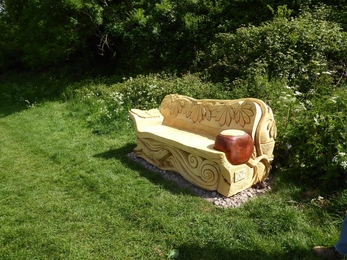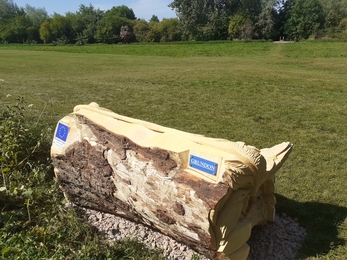The creation of wildflower meadows, a bat hibernaculum tunnel, restoration of the weirs and tree planting are all happening in Cirencester.
Cirencester has many waterbodies running through and around the town. As part of the project, work will be carried out to control the flow of water and lower the risk of flooding, as well as providing great habitats for birds like snipe.
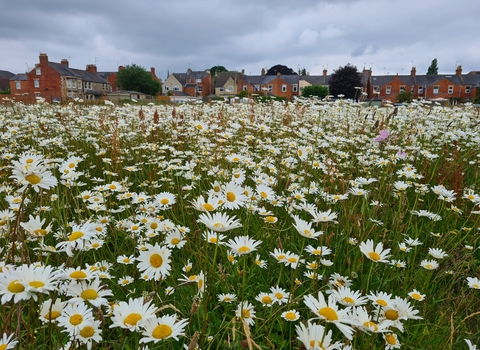
Cirencester’s wildflower meadows bloom
After two years of work by Gloucestershire Wildlife Trust, the true beauty of Cirencester’s wildflower meadows is being revealed to the town’s residents and visitors. Cirencester’s City Bank and Victoria Road are two of seven locations around the town enjoying improved biodiversity – which pollinators love – which are all part of the Cirencester Meadows Project.
City Bank faced some challenges, like flooding soon after the initial sowing, but is now blooming after extra yellow rattle and meadowsweet seeds were sown by hand towards the end of 2021. The Victoria Road wildflower meadow exceeded all expectations, with many different flowering species giving brilliant displays both years. Poppies were the most abundant species in year one, followed by ox eye daisies, birds foot trefoil, salad burnet, wild carrot and many other species in year two.
In order to manage the meadows, cutting at the end of season is required to stop nutrient levels building and favouring some species, and to stop dead vegetation blocking the next year’s growth. To do this cutting and removing work, the project has provided Cirencester Town Council with a flail collector to manage these extensive wildflower areas, including the meadows at Kingshill, which are also thriving, and where orchid species like common spotted, pyramidal and bee orchids can be found.
Before the work began
June 2019
We're excited to be working with Cirencester Wildlife Group to enhance the City Bank local nature reserve.
The short video linked below highlights some of the species that can already be found on this urban site. The project will be improving access into this area and will be aiming to increase the number of species that can be found there through the establishment of wildflower meadows which will provide an important nectar source for pollinators. We will be bringing further updates of the work we will be carrying out here as the project develops.
The meadows are sown
September 2019
In 2019, work started on City Bank local nature reserve, Kingshill and Four Acre Field with the aim of restoring the sites and emulating the meadows found nearby in The Cotswolds flower meadows. These will provide a splash of colour, the buzz of bees and provide wonderful locations in which people can escape to relax within a few minutes walk of the town centre.
One of the first steps was to turn the ground. It can initially look quite drastic, but this provides a good surface in which the seeds could grow and softens when they begin to germinate. Meadows take time to establish and flourish to their full potential. Although good growth was seen in the first year, it's in the second and third year where the better blooms are to be expected.
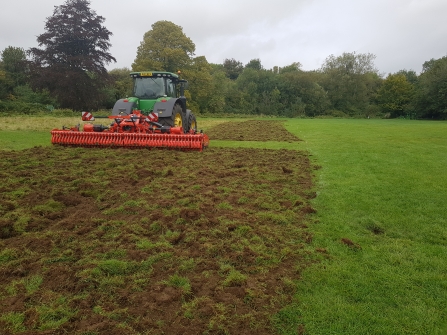
A seat on the wild side
After creating meadows, building bridges and planting trees, we gave ourselves five minutes to sit and enjoy this new bench in City Bank local nature reserve in Cirencester. In June 2020 this beautiful wildlife themed bench was installed, created by local wood carver, Andy O’Neill, with thanks to generous funding from Grundon and ERDF.
The bench has been placed overlooking one of our newly created wildflower meadows. Why not head down to this lovely local nature reserve. Located near to Cirencester town centre, it is a great place to go and spend an hour or a lunch break watching dragonflies dance over the river, listening to the birds sing and the bees buzz around the meadow.
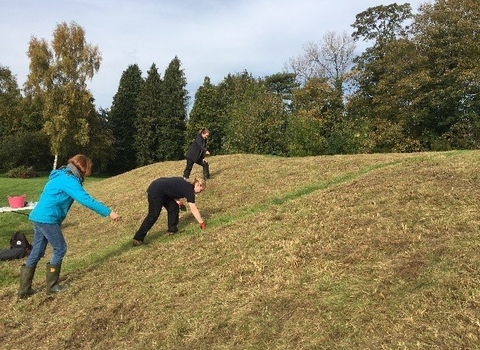
Working with FWAG
In June 2020 our project partners, The Farming and Wildlife Advisory Group (FWAG) have been busy with volunteers and the town council in various green spaces around Cirencester. The aim was to create new and enhance existing habitats for wildlife and the access for people between them.
Through the winter, a local group built a fantastic set of steps in the woods to improve access around the woods and between the Amphitheatre and the Four Acre Field. We helped them create an area of meadow in Four Acres, while FWAG carried out work in the Amphitheatre to create a wetland area. This wetland will provide a variety of wetland plants which will provide a selection nectar sources for pollinators.
Along a section of the Roman Wall, a day was well spent planting plug plants along a section in the Abbey Grounds. The bank formed by the old wall provides a great spot for wildflowers and pollinators. The slope improves the drainage of the soil and the soil itself is low in nutrients, which are the conditions that wildflowers like. This work was carried out as a joint effort between FWAG and the town council.
Tree planting in Jack Gardners Memorial Gardens
During the creation of the Hare Festival Way walk creation in June 2020, a selection of alder trees were planted. Now a few years older, these trees are flourishing.
To make this area even more successful, we gave the area a boost and planting a further 25 trees. These were planted just before the covid-19 lockdown was implemented and are growing very well. They will provide a mixed structure to the trees and will provide more resilience in the future. Trees in an area like this will absorb large quantities of water and help in times of high water flow.

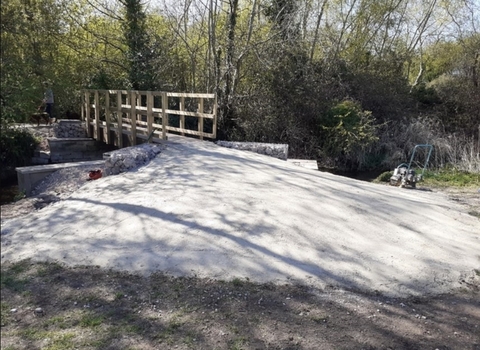
Connecting up
In April 2021, the finishing touches for the new bridge were completed at the old nursery with a gently sloping ramp to make the bridge as accessible as possible in its local nature reserve setting, connecting the Old Nursery site to City Bank.
The old bridge was narrower, inaccessible and had come to the end of its life, while the new bridge is wider to make general access easier, and now has no step up to it.

